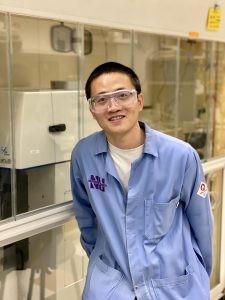Nanotechnology at Northwestern
Meet Zhijie Chen, a postdoctoral researcher in the Farha Research Group
August 25, 2020
Zhijie Chen is a postdoctoral researcher in the Farha Research Group, which seeks to solve problems in chemistry and materials science ranging from energy and environment related applications to challenges in national defense by employing atomically precise functional materials such as metal–organic frameworks (MOFs) and porous organic polymers (POPs).

Where are you from?
I was born and raised in Fuzhou, a city located on the southeastern coast of China. I got my undergraduate degree in chemistry from Shanghai Jiao Tong University in Shanghai, China, and then completed my PhD at the King Abdullah University of Science and Technology (KAUST), Saudi Arabia. After that, I moved to Northwestern University.
When did you first become interested in engineering?
I became interested in engineering when I was in elementary school. I loved reading different types of books related to science and engineering after school (in addition to playing soccer with my friends). I continued to study and was quite good at science subjects in middle school and high school. I transferred to study in the school of chemistry and chemical engineering as an undergraduate, although my first choice was mechanical engineering.
I conducted undergraduate research in Prof. Yong Cui’s lab. Fortunately, I had great mentors there and studied chiral porous materials including metal-organic cages and metal-organic frameworks (MOFs) for asymmetric catalysis and separation. Following that, I got a chance to conduct PhD research with Prof. Mohamed Eddaoudi at KAUST in Saudi Arabia. At KAUST, I had the opportunity and freedom to do fundamental scientific research in both science and engineering. I got excited about many aspects of science, particularly reticular chemistry and porous materials. I continued this research here in Prof. Omar Farha’s group, where I can still do what I like—designing materials at the molecular level and correlating their functionalities with structures.
How do you explain what you study to non-scientists?
One research topic in the Farha Group is to design and synthesize porous materials from single molecular building units, kind of like building a sophisticated version of Anna and Elsa’s castle from small Lego blocks following the desired blueprint. Some of my work in Prof. Omar Farha’s lab involves designing and synthesizing porous materials with molecule-level precision for hydrogen and methane storage, aiming for a clean energy future. These materials have ultrahigh porosity and surface area. Another strand of research involves using MOFs and related composites to efficiently destroy chemical warfare agents for personal protection. One of the MOF composites can destroy nerve agents through hydrolysis by using water from the air. This is because the nanoporous nature of MOFs enables them to adsorb water with high uptakes at low relative humidity.
Can you tell me about some potential applications for your work?
The potential applications of my research in the Farha Group include hydrogen and methane storage, nerve agent destruction, and water capture from air. We have developed a class of ultrahigh porous materials, which can storage much larger amounts of gases such as hydrogen and methane compared to the empty tanker. This result was published in Science earlier this year. We are currently working to make more efficient hydrogen adsorbents, hoping that they can be used in automobiles one day. We have recently published a paper in JACS, demonstrating that MOFs-coated fabric can efficiently destroy nerve agents using water from the air. These results show the potential that these composites could be used in protective masks or suits for personnel handling highly toxic hazardous materials. Additionally, we are working to design highly stable sorbents for water capture, and these results could be applied to harvest water from low humidity air at some specific environments.
What has been a highlight of your time at Northwestern?
I think the highlight of my research is the development of one of the most highly porous materials, which can be used for both hydrogen and methane storage.
What has been the most challenging aspect of your work or your time here?
I think the most challenging aspect is time management. Typically, I like to do experiments in the lab during the daytime, and then at night when I’m at home I can work on writing papers, reviewing papers from journals, and helping to write proposals.
Can you tell me about your experiences either being mentored or mentoring others?
The Farha Group is very collaborative and supportive. I enjoy spending time discussing research and doing experiments with students and visiting scholars at Northwestern. We like helping each other in our group—I would say we learn from each other. Whenever I’m solving problems for my colleagues in the lab, I feel really satisfied. I think my current research style was defined by the solid training and mentorship from my PhD supervisor, Prof. Mohamed Eddaoudi. As a postdoc at Northwestern, I learned and benefited a lot from my advisor, Prof. Omar Farha. He is very supportive and accessible.
What are your hobbies outside of the lab?
I like to play soccer at the lakeside soccer field in the summer. Also, I enjoy playing basketball with friends and swimming. On the weekend, I like to do hiking, go shopping and explore restaurants with my family.